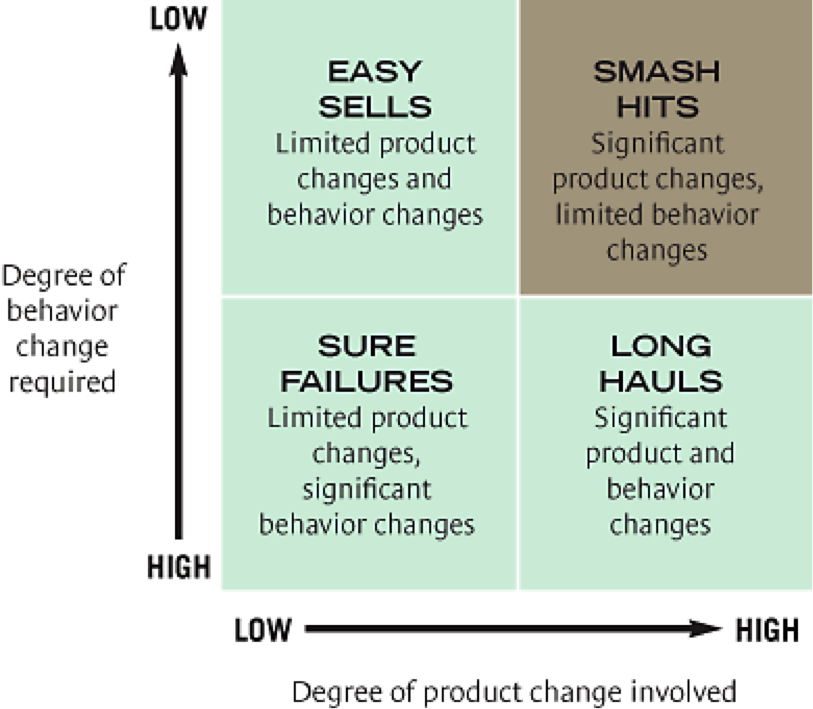In today's world with the consumerization of IT and the post-PC era we're seeing innovations at a dizzying pace, or are we? Yes, smartphones and tablets have outsold personal computers this past year and we're able to access the Web, multi-media, business and personal applications from these devices using wifi and 3/4G connectivity, but is that innovation or merely Moore's law in effect? Innovation requires a behavior change, but in order for that behavior change to be adopted the value of it must outweigh the status quo by a factor of 9. More detail on the 9x effect may be found by reading Eager Sellers and Stony Buyers: Understanding the Psychology of New-Product Adoption by John T. Gourville.
The basic premise of the 9x effect is that users overvalue the benefits of an incumbent product by a factor of three and developers overvalue the benefits of their product or technology innovations by a factor of three as well. This mismatch results in a factor of nine to one or 9x, between what innovators believe users want and what the users truly want or even need. Ultimately, in order for new innovation to become the next killer app it should strive for a 10x improvement over the status quo for people to adopt it and move away from current technology that offers similar functionality. Innovations that offer 10x improvements are rare and one of the reasons that so many have trouble "crossing the chasm".
How does innovation happen and become mainstream then? The chart shows four types of innovations that occur as a result of the change in behavior to the the change in product. Striking the proper balance will yield innovation that not only delivers value, but is also widely adopted.  These days, innovation in collaboration is wide-spread, but not every innovation is widely accepted.
These days, innovation in collaboration is wide-spread, but not every innovation is widely accepted.
Easy sells require the lowest change in behavior and deliver limited benefit to the user. In most cases, I would look at this type of innovation as new features to existing products that are delivered as updates and upgrades leading to a high rate of adoption. The addition of video with telephone calls is an easy sell that doesn't require a change in how the user initiates a call, only that they turn video on.
Sure failures require significant behavior changes or don't deliver value that outweigh the effort to use the product. There have been many products over the years that made a bold claim to be the e-mail killer. Yet, e-mail remains the killer app for communications to this day because every "replacement" has been more difficult or time consuming to use.
Smash hits don't require a significant change in behavior, but still deliver significant benefit. The use of e-mail and instant messaging in place of typing a memo or making a phone call have changed the way we communicate in the office and on the road with mobile devices. The use of simple and intuitive finger gestures on touchscreens replace the need for a mouse and pointer enabling people to quickly take control of how they interact with these devices.
Long haul innovations require significant behavior change and development of a new skill set, such as using the Android Operating System. The adoption timeframe can be quite long, but as the benefits are realized you'll see a typical s-curve rate of adoption. What can further drive the value is how easily innovators can extend and build on top of the technology with advanced solutions and streamlined processes.
When you consider new, innovative ways of collaboration- determine which of these four categories it falls into. Doing so will help you understand the landscape and position appropriately. Don't expect rapid and widespread adoption. Some people are simply resistant to change. Evaluate for a 10x improvement over the status quo. In some cases, you may need to eliminate older competing technologies such as document management systems and standardize on one. Target users who don't have an existing solution and believers that are open to using innovative products and will become evangelists. Finally, lead by example and have senior management support the change by being early adopters.
What are your thoughts for innovation in collaboration? Are you seeing it? What collaboration technologies are you seeing over-promise and under-deliver? What are the innovations you want to see in collaboration and are they the same innovations your user-base want to see?
